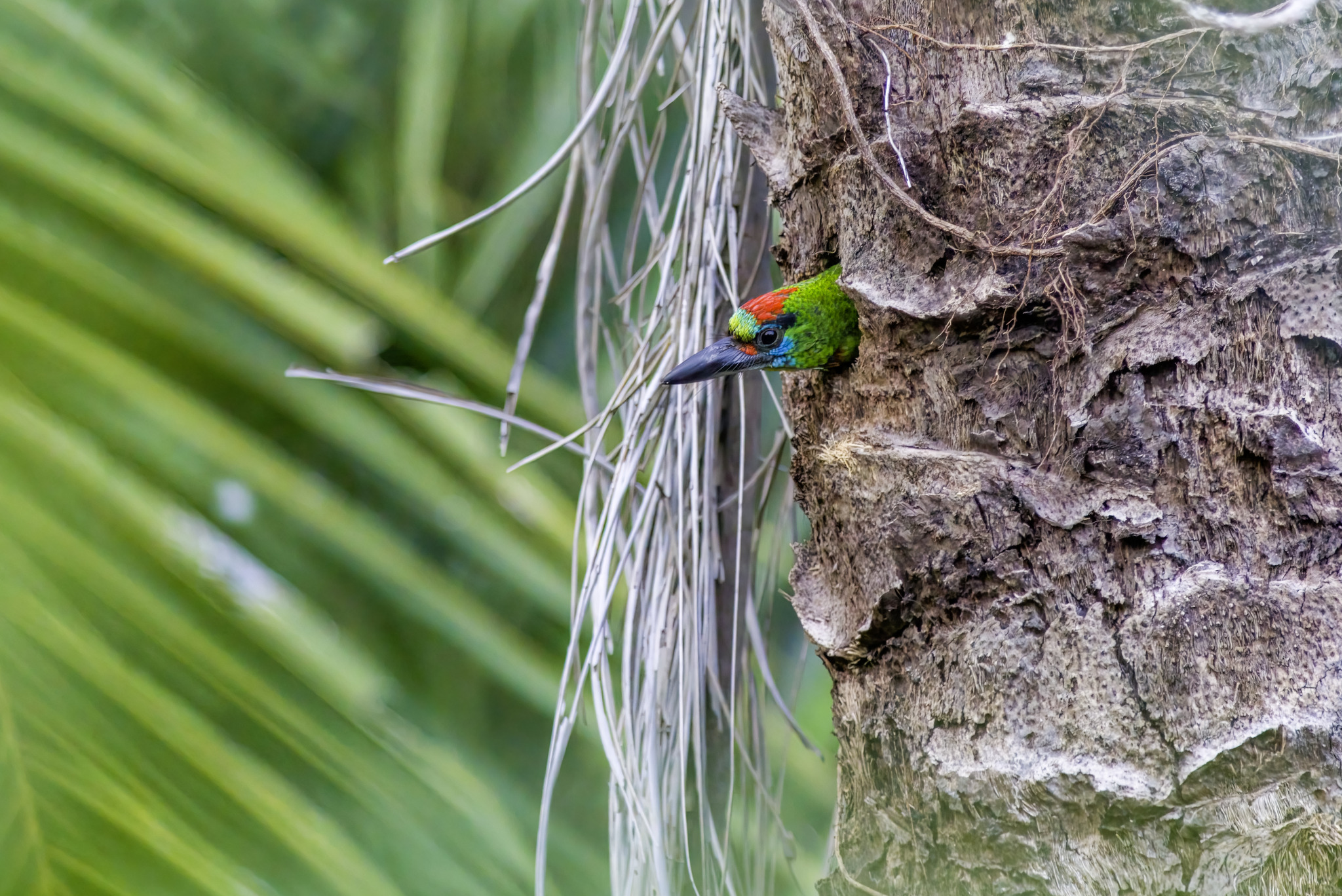The Red-throated Barbet (Megalaima mystacophanos) is a striking, medium-sized bird found primarily in Southeast Asia. This colorful bird is well-known for its distinctive red throat and vibrant plumage, and is part of the barbet family, Megalaimidae. Barbets are named for the bristles around their heavy bills, which help them grip and consume their primarily fruit-based diet.
Key Characteristics:
- Appearance:
- Size: About 20–25 cm (8–10 inches) in length.
- Color:
- Head: Bright green overall with a striking red throat and forehead, blue cheeks, and a small yellow patch above the bill. It also has black markings around the eyes and face.
- Body: The rest of the body is mainly green, with a blue patch on the nape and varying red, yellow, and blue streaks on the breast and flanks.
- Bill: Stout, with bristles at the base, adapted for fruit consumption. Typically, the bill is black.
- Habitat:
- Found in tropical and subtropical rainforests, especially in lowland and montane forests up to 1,500 meters in altitude.
- Prefers dense, primary forests but can also adapt to secondary growth and plantations. Commonly found in countries like Thailand, Malaysia, Indonesia, and Singapore.
- Behavior:
- Feeding: Primarily frugivorous, feeding on various fruits and berries, but also consumes insects, especially when feeding young. It is often seen in the canopy, hopping from branch to branch to pick fruit.
- Vocalization: Has a distinctive, repetitive call that sounds like “poop-poop-poop,” which can be heard over long distances in the dense forest. This call is often heard during the early morning or late afternoon.
- Social Behavior: Generally solitary or found in pairs, but may form loose groups when feeding on fruiting trees.
- Breeding:
- Breeding season varies by location but generally occurs from February to July. Red-throated barbets are cavity nesters, excavating holes in dead or decaying wood, often in tall trees.
- The female typically lays 2-4 eggs. Both parents are involved in incubating the eggs and feeding the chicks. The young fledge after about 4 weeks of hatching.
- Conservation Status:
- Listed as “Least Concern” by the IUCN Red List, but populations are threatened locally by deforestation and habitat degradation. The species is sensitive to forest loss and fragmentation, particularly in regions where logging and agricultural expansion are prominent.
Ecological Role:
As a frugivore, the Red-throated Barbet plays a crucial role in seed dispersal, contributing to forest regeneration and maintaining ecosystem health. By consuming fruits and defecating seeds across various areas, they help maintain biodiversity and the structure of tropical forests.
Cultural Significance:
Barbets, including the Red-throated Barbet, are appreciated for their colorful plumage and melodic calls. In some Southeast Asian cultures, their presence in the forest is believed to signify a healthy ecosystem. They are also occasionally kept as pets, though this practice is less common due to legal protections and habitat conservation efforts.
Interesting Facts:
- The bristles around their beak help them grip fruits and insects, and the strong bill is used for chiseling into tree bark to create nest cavities.
- Unlike many other bird species, both male and female Red-throated Barbets participate equally in nest excavation, incubation, and feeding duties.
- Despite their bright coloration, Red-throated Barbets can be surprisingly hard to spot in the dense forest canopy due to their green plumage, which blends well with leaves.
Conclusion:
The Red-throated Barbet is a vibrant and important bird species in Southeast Asia’s rainforests. Its colorful appearance and distinctive call make it a delight to birdwatchers, while its role in seed dispersal highlights its ecological importance. However, ongoing habitat destruction poses a threat to this and many other forest-dependent species. Conservation efforts are essential to ensure the continued survival of this stunning bird.
Views: 344
Subscribe to the newsletter:
